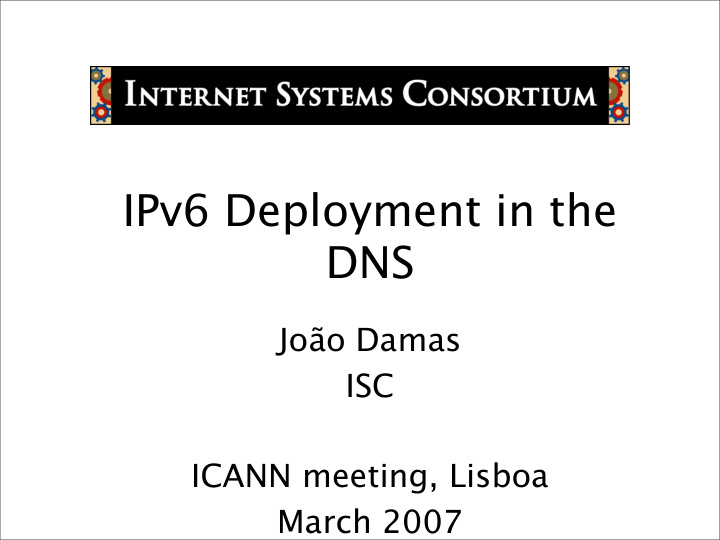



IPv6 Deployment in the DNS João Damas ISC ICANN meeting, Lisboa March 2007
Outline Protocol Implementations Usage
Protocol • Finalised several years ago – Final option selected is a simple extension of the IPv4 model – Forward DNS (Name to address): AAAA – Reverse DNS (Address to name): PTR • extended syntax – Other options (A6) declared experimental 3
Implementations • Various implementations available for the past several years • Choice of platforms, available for a length of period that permits full confidence in their behaviour • Well established operational practice – books, how-to docs, examples, discussions, support in provisioning systems 4
Usage • Initial deployment at leaf level of the DNS tree – several domain holders/operators working with IPv6 began introducing IPv6 information early on (e.g. KAME) • Progressive introduction at upper levels of DNS 5
IPv6 at the root • Finally reached introduction into TLDs in 2004 with the introduction of records for .jp (Japan) and .kr (Korea) in the root zone – On 20 July 2004 at 18:33 UTC the IPv6 AAAA records for the Japan (.jp) and Korea (.kr) country code Top Level Domain (ccTLD) nameservers became visible in the root zone file with serial number 2004072000. It is expected that the IPv6 records for France (.fr) will be added shortly. • Several TLDs 6
IPv6 at the root servers • Final step necessary for fully normal operation is the introduction of IPv6 information to enable IPv6 service of the root servers themselves. • Several root servers already have IPv6 blocks allocated for this purpose. 7
IPv6 at the root servers Some of those provide, today, service over IPv6. However, the lack of entries for them in the root and root-servers.net zone makes their use not accessible to the vast majority of Internet users. 8
Recommendation to ICANN • RSSAC and SSAC tasked with analysing impact and risks and present recommendation to ICANN. • Report finalised last week • To be presented to the board this week • hopefully quick process to enable full service. 9
Questions?
Recommend
More recommend